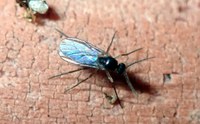Dakota Gardener: Houseplant Fungus Gnat Woes
(Click an image below to view a high-resolution image that can be downloaded)
By Esther E. McGinnis, Horticulturist
NDSU Extension
After a long summer of vegetable and flower gardening, we turn our attention indoors. Houseplants are a wonderful way to experience a touch of nature as we transition to the winter season. However, houseplants are not without challenges.
One of the most common problems for plant parents are insects. At first you see an occasional small unidentified flying insect (I call them UFIs) around the house. You dismiss it as a fluke. Next thing you know, you are regularly swatting these small dark-colored gnats that seem to be drawn to you and your houseplants.
The holidays are fast approaching and you don’t want Aunt Harriet to see your UFI infestation. What should you do?
As with any pest, the key is to accurately identify the pest. If the one-eighth inch flying insects resemble tiny mosquitos with long delicate legs and antennae, they could be fungus gnats. To definitively identify the pest, look at the transparent wings under a magnifying glass. Fungus gnat wings have a distinctive rounded “Y” pattern.
Fungus gnats are frequently found in houseplants. They can enter the home when a new plant is purchased or they can infest an existing plant that is placed outdoors for the summer.
While the adults are a nuisance, the real problem are the larvae. Each adult can lay up to 200 eggs in potting soil. The larvae feed on fungi and decaying plant matter in the top couple inches of potting soil.
Managing fungus gnats need not be a toxic battle if you understand their life cycle and their environmental preferences. The larvae thrive in overwatered potting soil.
To reduce the number of eggs that hatch and the number of larvae that survive to adulthood, cut back on watering frequency and allow the top two inches of potting soil to dry out before the next watering. This is the most effective option for managing fungus gnats. Most houseplants use less water during the winter and will benefit from less frequent watering.
To monitor for the adult gnats, place yellow sticky cards on stakes in the houseplant container. Yellow sticky cards can be purchased at garden centers. The color attracts the adults and they become stuck to the adhesive. If you see more and more adults stuck to the cards, then more control measures may be required.
To determine which houseplant in your collection is the source of the larval infestation, place a small cut potato on the surface of the potting soil. Check the cut end in a couple of days. If there are numerous larvae with black heads feeding on the potato starches, it may be time to treat the houseplant.
Rather than reaching for an insecticide spray, consider a less toxic option. The larvae are susceptible to biological products containing Bacillus thuringiensis subsp. israelensis (Bti). The scientific name is a mouthful but it is the active ingredient in Mosquito Bits and Gnatrol. These products are toxic to the fungus gnat larvae. Multiple applications may be necessary to achieve control.
Hopefully these control measures will manage infestations before your holiday get-togethers.
NDSU Agriculture Communication – Nov. 9, 2021
Source: Esther McGinnis, 701-231-7971, esther.mcginnis@ndsu.edu
Editor: Kelli Anderson, 701-231-6136, kelli.c.anderson@ndsu.edu




